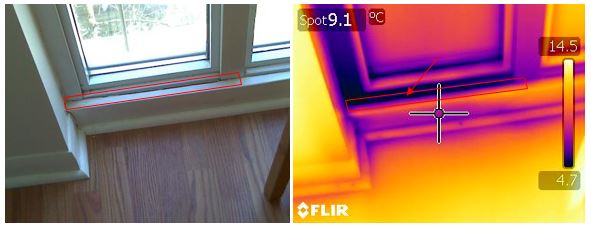‘Tis the season for snowy days, cold nights, and weather effects that can play havoc with condo properties. And while winter can bring all manner of property maintenance issues, few can cause as many headaches (or large repair bills) as unchecked condensation.
“You’d be surprised what condensation can do if it isn’t looked after,” says Jack Albert, Associate at RJC Engineers (RJC). “Once that moisture is present, it can damage finishes, drywall, flooring, and even lead to health concerns in extreme situations.”
Condensation occurs when interior humidity levels combine with winter exterior conditions at cold surfaces, most often windows and doors. The quality of the windows, as well as the details at the window perimeters where they transition to adjacent systems (e.g., precast concrete or brick), is often a large contributing factor. Air barriers and thermal control layers are used to protect these connecting points but can fail over time or be improperly installed.
Moreover, condensation can happen all year round but is especially pronounced in colder seasons. One reason is that air conditioning equipment is no longer removing humidity from the environment. Another is that condo owners will often use humidifiers to combat cold and dry air, and enhance comfort. Additionally, in the shoulder season (particularly, the fall), condensation often shows up as nighttime temperatures are dropping but interior humidity levels are still high, particularly with ERV systems.
Condensation can be a common issue in older buildings with less thermally efficient windows. It can also show up in newer buildings where poor building envelope detailing or lack of dehumidification can cause problems.
“It is something that we address all through the year, but typically get much more calls about condensation in the winter when the conditions are more extreme,” notes Albert.
Combating condensation
 Appropriate window detailing will often prevent condensation. In the absence of that, however, residents have a few techniques at their disposal. They include opening blinds to allow heat to get to the windows, using exhaust fans when cooking and washing, and generally monitoring humidity levels throughout the season.
Appropriate window detailing will often prevent condensation. In the absence of that, however, residents have a few techniques at their disposal. They include opening blinds to allow heat to get to the windows, using exhaust fans when cooking and washing, and generally monitoring humidity levels throughout the season.
That’s all well and good for preventing condensation, says Albert, but in cases where condensation has taken root over long periods of time, or the above steps are not eliminating the condensation, it pays to call on professionals: “This isn’t something you want to leave unchecked over a long period of time, because the repairs will add up.”
To that end, building envelope professionals like Albert will work with mechanical engineers to evaluate those HVAC systems to make sure they’re both working properly and working in concert with the building envelope system. They can also perform infrared thermography scans, conduct air leakage tests, carry out thermal reporting, and review building designs to find the root cause of the issue.
“There’s always the possibility that the walls or windows weren’t constructed properly to begin with, in which case we’d move to a repair or retrofit,” Albert notes, adding, “Of course, being proactive about condensation is a better bet. That’s why we also work with developers in the early stages of a development to assist in design detailing and specification during the design phase to reduce the risk of condensation in the first place.”
Condensation may not look like much of a problem at first glance. Still, like all building performance issues, it pays to take notice before the problem spreads.
Jack Albert is an Associate with RJC Engineers’ Building Science and Restoration. Learn more about RJC’s Building Science practice at rjc.ca.






Thank you so much for this important information
We are dealing with condensation in August. Any suggestions?
My condominium is planning to put in 10 mist fireplaces in the lobby , would you recommend this idea.